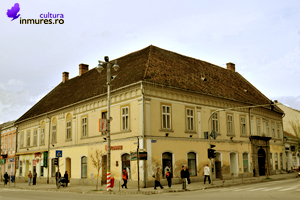
The Köpeczi House
Transylvania was the first of the Romanian Countries to experience Renaissance influences in architecture, though rather late, due to geographical, economical and social circumstances. Thus, by the end of the 15th century, while Italian Renaissance architecture was already in an advanced stage, the first transitional elements from the Gothic trend to the Renaissance appear in the cities of Transylvania. The elements of Transylvanian Renaissance were to be defined by mid-16th century when, among other favorable circumstances, Italian architects or builders such as Domenico da Bologna or Petrus Italus of Lugano were present in Transylvania. Among the most relevant examples of Renaissance architecture in this period are the Matei Corvin House of Cluj-Napoca, the Haller House of Sibiu, the Silverer”™s House in Bistrita, the Castle of Gherla etc. The economical and social stage of development of Tîrgu-Mureș at the middle of the 17th century did not allow for the local noblemen””a community not fully defined – to erect such buildings as those found in important urban centers of Transylvania. This is confirmed by the small number of buildings dating from this period. The two Renaissance buildings of Tîrgu-Mureș are the Köpeczi House (1 Revoluției St.) and the Nagy Szabó House (61 Trandafirilor Place). Built in 1554 by Köpeczi Tamás, a high dignitary of the Transylvanian Principate, contemporary of Isabella Jagiello, the wife of Ioan Zápolya, the Köpeczi House is the oldest building in the city. Several important families successively owned it. At the beginning of the 17th century, the family of chronicler Nagy Szabó Ferencz bought the house, while in 1631 it was granted a special statute by Gheorghe Rákoczi I who turned it into a guest house for very important persons passing through town. In the middle of the 17th century it became the property of the Borbély family, and later, in 1756, it was bought by the Telekis.
Not many elements of the first construction stage still exist. Some of these are the L-shaped structure – typical for the houses of that period – and the structure of the basement, covered by cross archways and semi-cylindrical archways with penetrations. The exterior walls of the ground floor also date from the middle of the 16th century, as well as fragments of the interior separating walls. The current shape of the door and window openings is definitely the result of later modifications, as they do not match specific 16th century models, neither in what concerns the framing, nor as far as their dimensions are concerned. The sumptuous portal of the street entrance on Revolutiei street was built between the two world wars out of a material that imitates stone. The semicircular opening, flanked by two pilasters attached to the building and the strongly-profiled cornice are elements of the Renaissance. The floral and zoomorphic ornaments slightly relieved on the stone surface add a note of eclecticism to the ensemble. The top floor added during the ownership of Teleki Lászlo at the middle of the 18th century shows structural elements specific to the Baroque: larger spaces, covered by arched ceilings reinforced with double arcs. The remodeling and building of the top floor of the old building were lead by architect Paul Schmidt, who also designed the most beautiful Baroque building in town, the Toldalagi Palace. On the exterior, the decoration of the top floor which was done at the beginning of the 19th century in a quasi neoclassicist manner consists of Doric pilasters and a continuous frieze made up of metopes and triglyphs, placed underneath the roof. In the 19th century, the then owner of the house, Teleki József, establishes the first nucleus of a natural sciences museum in his home. At the middle of the 19th century, the town”™s casino was hosted by the Köpeczi building.
Bibliography:
Ioan Eugen Man, Tîrgu-Mureș, istorie urbană de la începuturi până în 1850, Tîrgu-Mureș, Ed. Nico, 2006, pp. 124-126.
Keresztes Gyula, Marosvásárhely régi épületei, Marosvásárhely, Difprescar, 1998, pp. 98-100.
Grigore Ionescu, Istoria arhitecturii în România, vol. II, București, Ed. A.R.S.R., 1965,
Virgil Vătășianu, Istoria artei europene II. Renașterea, Cluj-Napoca, Ed. Clusium, 2000, pp. 182-183.

